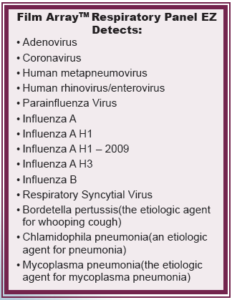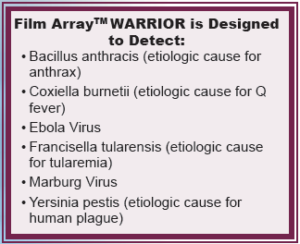Consider the work of a military medic in the field when a warfighter comes on sick call complaining of a sore throat, cough or fever. Aside from suggesting an analgesic and fluids, should the medic return the warfighter to the unit where he or she may spread illness and endanger others? At present, options can be that limited. The medic might take a nasopharyngeal swab and hope a supporting Clinical Laboratory Improvement Amendments-certified lab gets back with a diagnosis in two to three days; but in that time members of the unit are put at risk of catching an infectious disease and the unit may lose effectiveness.
From 1918 to 1919, the U.S. military faced that very problem, when an illness known as Spanish Flu spread worldwide, causing an estimated 20 to 50 million deaths [1]. U.S. Naval estimates put infection rates among its members at 40 percent. In one particularly serious outbreak, the USS Pittsburgh suffered an 80 percent attack rate among its crew when the ship’s captain allowed his crew to go ashore while Spanish Flu raged in Rio De Janeiro [2].
The obvious problem is that military medical personnel and commanders need to know when unit members catch a contagious illness, but current diagnosis often takes too long to report back disease status. Using BioFire’s FilmArray® RespiratoryPanel, detection of multiple respiratory pathogens takes only one hour. However, U.S. regulation under the CLIA of 1988 [3] requires laboratories conducting moderate to high complexity human diagnostic testing must receive certificates of compliance or accreditation that require highly trained professional laboratory staff. Settings in which medics, pharmacist’s mates, nurses and even physicians may perform testing generally cannot qualify for these levels of certification because they lack education and experience.
In order to get the diagnostic capability closer to the warfighter, the Defense Threat Reduction Agency contracted with BioFire Defense/BioFire Diagnostics to conduct clinical studies that can allow the U.S. Food and Drug Administration to grant CLIA-waiver for a simplified version of the FilmArray® RP. In Summer 2015 those studies concluded, and the BioFire team submitted its application in October 2015 to FDA’s Center for Devices and Radiological Health. If the CLIA-waiver is granted, DoD can deploy the simpler FilmArray™ RP EZ into less specialized settings (e.g., clinics, ships or aid stations) where sick warfighters can receive diagnosis and begin treatment in an hour. All the while, the unit overall is spared the risk of infectious disease.
FilmArray™ Respiratory Panel EZ
With the RP EZ, medics and pharmacist’s mates undergo simple video-based training lasting only minutes [4]. The training enables users to collect patient samples, run the diagnostic test, interpret results and even perform routine system maintenance. The FilmArray® itself consists of a laptop computer, disposables (reagent vials, plastic transfer pipettes and diagnostic pouches), a pouch loading station and a testing instrument.
Only the laptop and instrument require power, and nothing in the system needs refrigeration. Requiring less than five minutes of hands on use, the FilmArray® is a load and go system.
Using Polymerase Chain Reaction technology, RP EZ reliably detects 14 common respiratory pathogens.

FilmArray® WARRIOR
In partnership with the Joint Program Management Office for Medical Countermeasure Systems, BioFire Defense is also developing a panel to detect some of the most feared pathogens for its WARRIOR panel, which is intended for military use. Under separate contract with DTRA, Bio-Fire, JPM MCS and DTRA representatives took the WARRIOR system to FDA’s Center for Devices and Radiological Health early in 2016 and entered into presubmission discussions on whether the WARRIOR panel could also be made eligible for a CLIA waiver.

Future Developments
While the WARRIOR panel is probably years away from FDA clearance, military users can begin using the FilmArray® RP EZ system more quickly if it receives CLIA waiver. Also, BioFire Defense is working with JPM MCS to tie the FilmArray® laptop into the DoD’s Global Information Grid, so that commanders can eventually gain insight into unit effectiveness in near real time. Lastly, depending on BioFire’s company strategy the FilmArray® RP EZ could also become available at civilian locations, so that all Americans may one day hope for one hour diagnosis of colds, influenza and other respiratory illness.
References
1. Nelson, K., “Infectious Disease Epidemiology: Theory and Practice” (2nd Ed.), Jones and Bartlett, Sudbury, MA (2007): pp. 586-588. ISBN-13: 978-0763728793.
2. Luke, T., Halenkamp, T., and Kilbane, E. “Naval quarantine: Impervious to epidemics of virulent disease.” (2006). Proceedings of the US Naval Institute, vol. 410, July Issue, pp. 48-53. Retrieved from http://www.usni.org/document/luke-thomas-timothy-halenkamp-and-edward-kilbane-2006-132-7-1241pdf?magazine_article=78948 (accessed April 25, 2016).
3. BioFire.com. (2016, April 25). BioFire FilmArray System. Retrieved from www.biofire.com: http://www.biofiredx.com/products/filmarray/(accessed April 25, 2016).
4. Government Printing Office. (2016, April 26). USC 42, subpart2-clinical laboratories, part 263a, certification of laboratories. Retrieved from www.gpo.gov: www.gpo.gov/fdsys/pkg/USCODE-2011-title42/pdf/USCODE-2011-title42-chap6A-subchapII-partF-subpart2-sec263a.pdf (accessed April 25, 2016).
United States Air Force Lieutenant Colonel David G. Watson currently serves as the chief of the Assays and Biomarkers Branch; Diagnostics, Detection and Disease Surveillance Division; Chemical and Biological Technologies Department at the Defense Threat Reduction Agency. In coordination with the Joint Program Executive Office and Joint Requirement Office, he programs and executes science and technology projects to meet the current and future requirements of the Department of Defense’s Chemical and Biological Defense Program. In his current role he is responsible for all technical, managerial, and staff functions required to plan, integrate, and execute the branch’s mission to develop and validate rapid, sensitive, and specific tests for the identification of chemical biological warfare agents and their expressed pathogens and toxins.
Dr. Richard Schoske serves as the chief of the Diagnostics, Detection and Threat Surveillance Division for the Defense Threat Reduction Agency – Chemical and Biological Defense Research Directorate. Dr. Schoske oversees and manages a $100 million research and development portfolio, which includes projects in the areas of platform development for the diagnostics, detection and disease surveillance. Dr. Schoske’s educational background is in biochemistry and he has applied this knowledge in operational work experiences involving the development and deployment of novel medical diagnostic systems for the U.S. Air Force. Furthermore, Dr. Schoske has an extensive background in counter chemical-biological consequence management planning. Prior to joining DTRA, Dr. Schoske served in the Air Force for 21 years and is a retired Lieutenant Colonel. Dr. Schoske is an American Society of Clinical Pathologists Certified Medical Technologist, and possess a master’s degree in biochemistry from the University of Scranton, and a Ph.D. in chemistry from American University in Washington, D.C.


